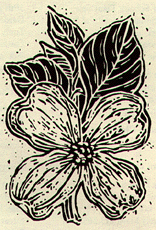by Paula Panich

If you find yourself without a toothbrush, you might chew the end of a fresh twig to clean the teeth - think of the lovely Gwyneth Paltrow at the window in Shakespeare in Love.
Four hundred years ago, almost to the moment, the English botanist and barber-surgeon John Gerarde was cataloguing the plants in his garden. In a corner he saw a dogwood, and mused over its many names – “Hounds tree, Hounds berry, Dogs berry tree, Pricke-timber . . . Gater tree.” But what could this lovely tree have to do with dogs, or with gaters, for that matter? The Shorter Oxford English Dictionary gives us no hint of what gaters might be, at any rate. In 1831 John C. Loudon in The Hardy Trees and Shrubs of Britain, wrote that the ornamental dogwood (Cornus florida) was called such because a “decoction of its leaves was used to wash dogs, to free them from vermin,” but more recent writers have found no evidence of such a use. Dogwood has been used to make toothpicks, and its crushed bark could intoxicate fish if thrown in water.
Several sources have suggested “dogwood” to be a corruption of “daggerwood” – as the in the whittling of wood to make a small knife. Its fruits have been used to make soap; its bark has been boiled in water to soothe sore muscles and to bring on a sweat to cool a fever – thus its reputation for being a substitute for quinine. If you find yourself without a toothbrush, you might chew the end of a fresh twig to clean the teeth – think of the lovely Gwyneth Paltrow at the window in Shakespeare in Love.
In Native American folk-lore, there’s a story about a greedy chief with four daughters, who called for suitors to bring him rich gifts. The gods weren’t pleased; this was no way for a chief to behave. The gods took measure of his mean spirit, and turned him into a small, low tree with bent branches – one that will never grow tall. His four daughters are still with him – the four white bracts surrounding the clustered flowers.
Writer Robert Hendrickson reports that in 1907, an informant to an issue of American Folklore explained that a “dogwood winter” was a spell of bad weather in May, when the dogwoods are ablooming – several days of “cold, disagreeable, cloudy weather, and often a touch of frost.”
When our sole dogwood (C. florida ‘Rubra’) is covered (we hope) by tiers of intoxicating flowers enclosed in elegant pink bracts, may we be spared from that spell of “dogwood winter.” We’ve had enough winter already.
– Paula Panich
